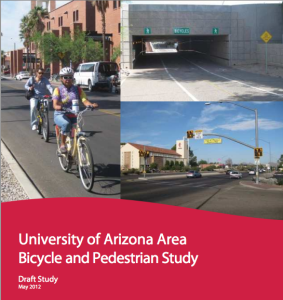 Last week, the Pima Associates of Governments released a 165-page draft bicycle and pedestrian plan prepared for the University of Arizona.
Last week, the Pima Associates of Governments released a 165-page draft bicycle and pedestrian plan prepared for the University of Arizona.
The study, which was prepared by Portland-based planning company Alta Planning and Design, “aims to improve existing and future bicycle and pedestrian conditions for students, faculty, staff, and visitors.”
Officials from Alta will be at tonight’s Tucson-Pima County Bicycle Advisory Committee meeting to discuss the plan and its findings.
A public open house is set for 6-7:30 p.m. on Thursday, June 14, at the UA Swede Johnson Alumni Building, 1111 N. Cherry Ave. The open house is designed to let the community check out the plan and offer comments on it.
The study suggests that 40 percent of the people who drive to campus live less than five miles away, creating an opportunity to encourage that group to utilize non-motorized transport to get to campus.
The study found five overall objectives to improve conditions on campus. They are:
• Reduce collision risk: Identify potential conflict points on campus and create solutions to better
manage bicycle and pedestrian flow.
• Improve existing infrastructure: Identify strategies to develop and enhance the existing campus and
area bicycle and pedestrian infrastructure with a focus on access, connectivity, and safety.
• Develop design standards: Define bikeway and pedestrian infrastructure standards to guide future
development.
• Increase bicycle and pedestrian mode share and safety: Guide development of both marketing and
education programs to increase mode share and safety.
• Implementation: Outline implementation strategies to help the University of Arizona and the City of
Tucson carry out the specific recommended improvements and programs.
The most interesting part of the report is the recommendations, which start on page 89 of the report. They are:
View UA Bike/Ped improvement suggestions in a larger map
1. Cycle track around UA Mall
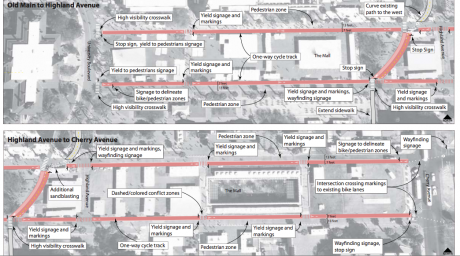
The planners propose putting a cycle track around the University of Arizona Mall to reduce conflicts between cyclists and pedestrians. The proposal includes putting a cycle track on both the north and south side of the mall eliminating the section of the mall that is currently off limits to cyclists.
Estimated cost: $22,000
2A. Improve 5th Street and Euclid crossing (short term)
The report suggests improving the 5th Street and Euclid crossing by adding better signage, adding sharrows along 5th street and creating a bike path into the university on the east side of Euclid.
Estimated cost: $11,000
2B. Add toucan to 5th Street and Euclid
The report suggests in the long term a Toucan should be installed at the intersection to make it the prime entrance into the University of Arizona for east/west bound cyclists.
Estimated costs $250,000
3A. Improve multiple 6th Street crossings at Tyndall, Park, Fremont, Santa Rita and Cherry
The report suggests many items to make it easier for bikes and pedestrians to cross 6th Street. Some improvements include adding a toucan at Tyndall and 6th. Reconfigure the Park Avenue and 6th Street intersection and add a crosswalk at Santa Rita.
Estimated cost: $413,000
3B. Perform a road diet on 6th Street from Stone to Campbell with buffered cycle tracks
The report suggests performing a road diet along 6th Street from Stone to Campbell Avenues. The travel lanes would be reduces from two in each direction to one in each direction and would add a buffered cycle track, add landscaping and sidewalks.
Estimated cost: $1,000,000
4. Extend Highland Avenue bike path from Helen to Mabel
The report suggests adding a one block section of bicycle path along the westside of the Highland parking garage to allow cyclists to continue north through the area, which would reduce congestion at Mountain Avenue and Helen.
Estimated cost: $19,000
5. Cycle track adjacent to streetcar line on Second Street
The report suggests creating a cycle track parralell to the streetcar route on Second Street from Park Avenue to Highland Avenue. The cycle track will prevent conflicts with the streetcar.
Estimated cost: $56,000
6. Improvements to Mountain Avenue from Helen to 2nd Street
The report suggests creating a small traffic circle at Mountain Avenue and Helen to help reduce conflicts at the intersection. They also suggest improving pedestrian refuges and adding sharrows south of Speedway Boulevard.
Estimated cost: $34,000
Broad recommendations were made for the areas surrounding the University of Arizona. Download the report and read those recommendations starting at page 107.
Here are some of the other interesting tidbits from the report.
- There are 9,699 short-term bike parking spots on campus. 96 percent of them are “inverted U” type racks.
- There are 1,700 long-term bike parking spots on campus including bike enclosures, lockers and residence hall bike rooms.
- There have been 1,083 reported bike crashes from 2007 to 2010 within the study area, which is five miles around the UA. More than half resulted in minor injuries. One percent were fatal.
- In the same time period, there were 848 pedestrian crashes, while 5.5 percent were fatal.
- Reported bike thefts from 2006 to 2010 have declined by 25 percent.
- Nine percent of UA employees rode to work in 2010, which is up from 7.9 percent in 2007.
- 67 percent of UA employees drive to work alone.

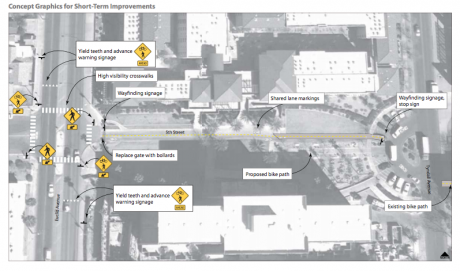

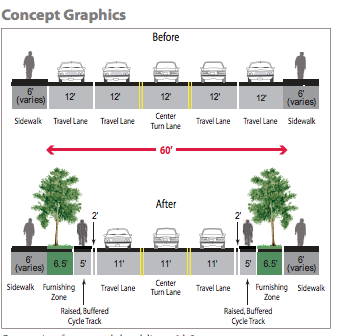
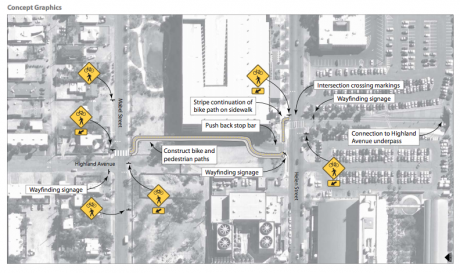


I was curious as to how much back and forth has been going on between different departments and agencies. For example, the one project which stood out to me was the road diet of 6th Street. I think this has been one of those projects that comes up every 10 years or so and then gets shot down each time by the community at large. Is the City really willing to go ahead with something like this? If so, that is a huge step forward.
Back in my days as a UA campus employee, commuting to work by bike was really out there. As in, you were really WEIRD if you did something like that.
Which is why I’m glad to see that commuting conditions are finally being addressed.
But I’m disappointed to learn that 2/3 of UA employees still come to campus in their cars. By themselves.
Which says to me that the bicycle wierdo factor still exists. Or something like that.
I particularly like the proposal to make 6th St two lanes with dedicated bike lanes like Mountain.
Not so sure about the cycle track on the north side of the mall near the Student Union… that’s a pretty busy ped area and having it off limits to bikes ( as it is now ), is probably a good call. Those extra signs look to be a bit bothersome. I really like the crossings on Euclid. Right now, it’s dicey to get across Euclid with the closure of University for construction. I think you could do a lot with employee cycling if they had good places to store their bikes ( like in their offices ? )
There are so many signs on the U of A campus, so many signs in Tucson, signs are a waste of taxpayer money and the useless ones are ignored and defaced. Trees, that was done on Stone, the ones that aren’t dead, aren’t well maintained, here we go again. It’s indicative that this meeting is at a building where the road is closed and it’s a hassle to access. My prediction is that there will be lots of tax dollars wasted, TREO style!
Yes. Campuswide policy prohibits bicycles from all buildings. This is nuts.
I’ve been saying there needs to be a road diet on sixth for years. I think it should be on the whole stretch though all the way to Wilmot. Same for Country Club…
A toucan at 5th would be great too. The other stuff is just kind of whatever.
The Swede Johnson building access from Speedway is indeed closed.
But you can get into the parking lot from Helen Street, which is a block north of Speedway. And, last I checked, Swede Johnson did have a bike rack out front.
See everyone at the workshop tonight!
I like almost all the ideas propsed. The exceptions are for riding in front of the student union and for bike lanes on 6th. Bike lanes on heavily trafficed streets are stressful to cycle on. Why would anyone want that experience when they can go a block or two over and ride in a residential area? Let the cars have the big streets. We will get a far more pleasant experience for less money if we develop bike routes along quiet streets by turning stop signs the other way at minor cross streets and providing shelter islands at arterials.
3wheeler: I commute from Alvernon to Mountain on 3rd…3rd is very pleasant, and when I ride with my seven year old son it is ideal, but for covering the six miles to work at Prince…I’d like to move fast and 3rd does not accommodate that. There are too many stop signs, too many turns and too many lights that have secondary priority to the north south streets. In other words, it’s slow. I think we should have both.
I completely agree with James that a 5th/6th street diet should extend to Wilmot – with the existing 30 mph speed limit strictly enforced. That would be a wonderful place for experienced riders to get across town.
Yeah, I’ll like to see 3B. happens but extend it to Tucson Blvd.
Sometime I take 6th St from El Con Mall or Reid Park area to 4th Ave… I get there real fast… better than 3rd st. I even wondered why there’s no bike lane on 6th and also said to myself this lane should be bus/bike lane only… like Broadway. 🙂
I think it’s important to note that they are calling for a buffered bike lane with a raised curb.
There was a conversation about the term “low-stress” and how and where it should be applied in regards to bike routes at last night’s BAC meeting.
Some liked to use it because it is a current term being used by planners and transportation types. You know, as far as communicating in their lingo. Others thought it put out an incorrect implication. The professional folks may have a unified notion in their minds of what “low-stress” is, but it is very undefined and subjective to the riding population…as we sense in the conversations above. The BAC actually voted on this and decided not to use the term in the particular instance… by one vote.
I think that was correct because it is way too nebulous a term for the audience they are communicating to. Rider skill level and the intention of the ride really determine the amount of stress someone might get from any street. Oh, and around here, the condition of the pavement and amount of debris along the side, ect. (tracks?)
I’d agree that 5th/6th and maybe Country Club offer the best potential for multi-modal transportation corridors that riders of of the widest level could find useful. But as they are now, I don’t ride them.
I almost recommended to a cyclist on Country Club that he should ride on Tucson. To my mind, riding on Country Club is suicidal. I thought better of it though…anyone who’s riding on Country Club is clearly not in a state of mind that will take a recommendation in the right spirit.
Of course I’d love it if 6th/5th St was 2 lane with bike path all the way out to Wilmot. I’m not sure how that would work though. Campbell to Stone is carrying what, 26,000 cars a day?
Went to the presentation at the Swede Johnson bldg last night, 4 actual bike parking spots with another 4 useable spots 100 yards to the west at another bldg. That sure seems like a swing and a miss to me. And while I’m on the subject why is it that so much bike parking is incorrectly installed and or poorly designed? Nobody expects cars to park in a way that damages their paint. Target El Con, the rack is against the wall so you can only lock to it longways. Sunflower 1st Ave, the little red hoop racks which I like are installed in a way that most everyone uses them with their bikes perpendicular to the bldg. which means that the 2 bikes will end up touching each other. Park parallel and there’s enough space.
Cycle tracks through UA mall, I’m mixed. I kind of like how it is now. Chaos seems to be working. I worry that if tracks were installed we’d end up with more restrictions and faster bicycle traffic. I do not think faster would be better. Too many texters to make that safe.
The proposed crossing enhancements along Euclid between 6th and Speedway, yeah sure but the best way to get east west in this area is University. The current absolutely most useful bicycle route will now have a streetcar in the middle of it. I’m not ready to cede that territory yet. 5th is problematic at least twice a day because of Roskruge/Tucson High bus and drop off traffic. Has to be seen to be believed.
What I’d like to see fixed is that deathtrap of an underpass at the 4th Avenue tunnel. That only one person has been killed there is a miracle. The conflict between right turning cars and bicyclists is extreme. Nobody pays any attention to that bike box and the no right on red restriction. The other thing about the no right on red restriction is if it applies to bicyclists which I think it does means that in off peak hours it makes absolutely no sense. Do bikes even trigger that light? I’ve sat waiting for a car to come and get me a green just to make a quick right to get to the Saturday Maynard’s Market.
The presentation had a chart listing I think 4 kinds of cyclists from fearless to I won’t ride near cars ever. I guess I’d count myself amongst the fearless transportation riders and for me I don’t see a whole heck of a lot in this plan that makes my life easier or better. Of course I might not be the target audience for these proposed enhancements. Oh well.
My moniker is 3wheeler because my main ride now is a recumbent tricycle. I ride pretty slow and I stick to residential streets. I have also been a road bike riders for 33 years. When I’m on the road bike, I fit in the “No Fear” category, I’ve ridden the shoulder of interstate highways and I’ll put my travels up to 90% of the riders out there. With my credentials stated, I agree that residential streets are going to be too slow for some people even after the stop signs are turned around. It doesn’t change my opinion that the huge amount of money that would go into 5th/6th would be better spent on residential streets. I said in my previous note I want stop signs turned, in plain English that means you never stop at a stop sign on a bike route except at primary and secondary streets. You get 1/2 mile sections to fly. The study is about improving biking around & to the UofA, let me point out there is already a bus/bike lane on Speedway and on Broadway too. The fearless folks who are in a hurry can still ride those.
Putting 6th on a road diet would a boon to bikes and pedestrians near campus and Fourth Avenue. Something that might make this road diet possible is the completion of downtown links andf the direct driving connection of Aviation Highway to I-10 via 7th avenue and East 6th/west Saint Mary’s. Comepletion of this motor vehicle project will likely result in more traffic on Aviation and less on 6th street. Agreed with others. Narrow 5th/6th all the way to Wilmot. A turn land an a travel lane in each direction. This design would not result in much less traffic capacity than the current two lanes each direction and no turn lane. My own experience driving on 5th 6th is that there is a fair number of folks turning and thus reducing traffic capacity as it is anyway.
Here’s a quote that I love……….
“My point is that cyclists understand when anybody says we can be safe(r) in areas consistanly being designed to accommodate more cars, they are lying.”
The quote is not referencing any previous comment, it’s just that there would have to be a great deemphasizing of cars if 5th/6th was to become a true corridor. No turn lane, 8-foot bike lane, 25 mph max speed and any other bicycle amenities you could think of. Then you would have a greatly lowered-stress, multi-modal route that served downtown, 4th Ave., U of A, El Con, schools and churches on out east and equidistant from all businesses on Speedway and Broadway. Out of that huge residential area that it would serve, you would tempt some people to ride on it rather than drive on Broadway or Speedway. That’s assuming you weren’t going to spend a bazillion dollars widening Broadway to twelve lanes.
There has to be a tangible advantage in choosing to bike that drivers can see from the seat of their car in order to lure them out.
Wow, that’s really good there zz. Smartest thing about bikes I’ve read in a really long time. thanks
I strongly urge that the area between the trolley tracks and road be filled to prevent wheels from entering and bikes going down. I had an accident at 4th avenue and Congress.
Here’s an idea. It has two parts.
1) UA/Board of Regents: tear down all but three parking garages.
2) City of Tucson: aggressively enforce neighborhood parking restrictions (aggressively=boot the cars of violaters, don’t just lazily ticket them).
Prediction: within a few years there will be profound improvements in mass transpo and bike infrastructure both on campus and spanning out two miles.
totally agree @ the 4th ave/congress underpass- NOT a fan as a pedestrian, driver, or biker- i just plain avoid that intersection when at all possible…